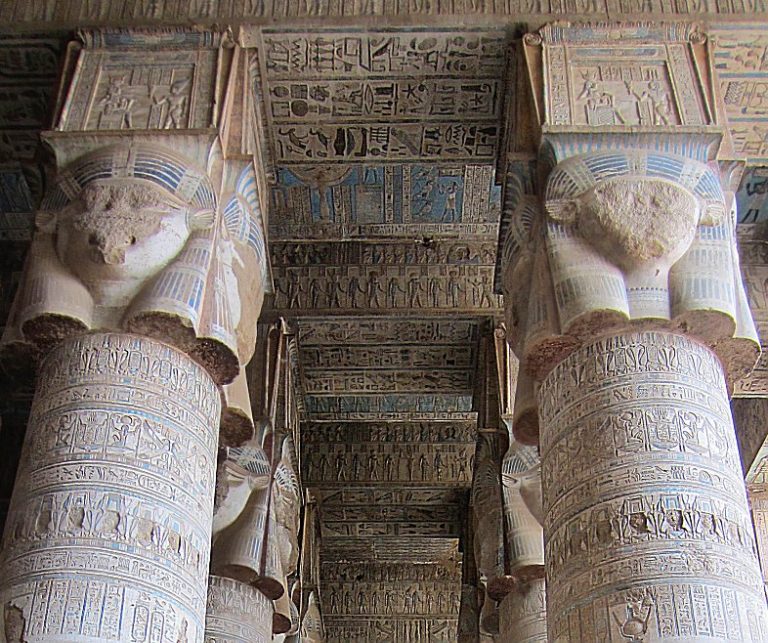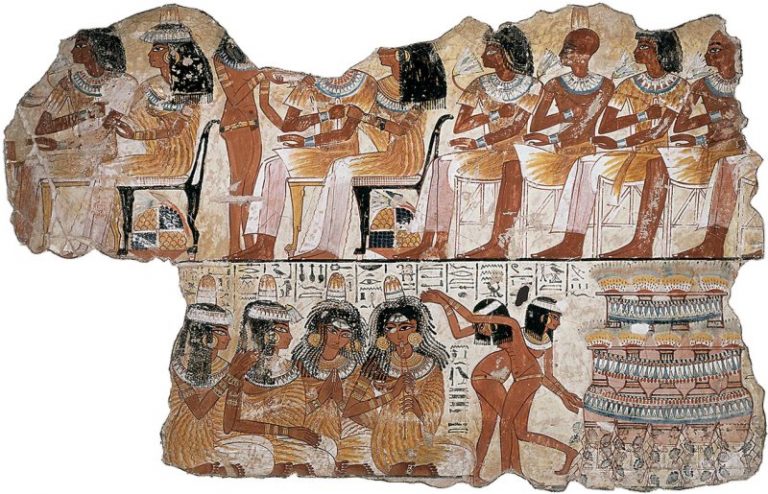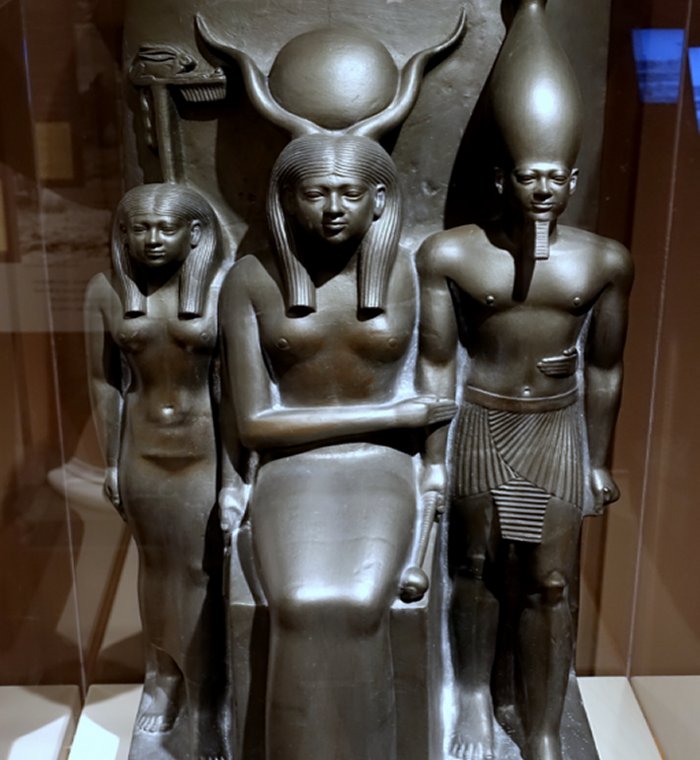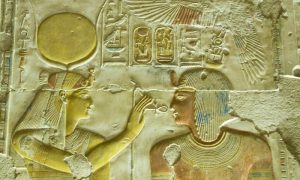One of the most venerated female gods in ancient Egypt was Hathor.

One of the largest and most complex pantheons of gods belongs to Egypt. In this pantheon, Hathor is a goddess of heaven and mother, depicted with a cow horn (or cow’s head) and a sun disk on her head.

Hathor passing the Ankh to Seti. Image credit: BasPhoto – Adobe Stock
No doubt, one of ancient Egypt’s most outstanding female deities is Hathor. She is believed to have been worshiped already during the pre-Dynastic Period, but most evidence of her importance can be found in records of later dynasties.
Occasionally, she is mentioned in the Pyramid Texts and much more often in the Coffin Texts of the late third millennium BC (the “Eye of Horus), and later, in other religious, literary works.
In the north, in the Nile Delta, she was also the “Eye, taking the form of the guardian cobra goddess Wadjet, whose symbol was placed on the forehead of pharaohs.
Most of the goddess’ common forms were a cow, a lioness, a snake, a sycamore tree, or papyrus, which “was the home of Hathor, the sky, and mother goddess as she was a goddess. ” 1
In her cow form, Hathor was a life-giving goddess closely related to fertility. She was also seen as the symbolic mother of each pharaoh. However, it was not the only link between her and the pharaoh. Hathor was Horus’ wife, and each pharaoh was believed to be the earthly embodiment of Horus.
Because of this link, each pharaoh had a right to be described as “the son of Hathor.”

Hypostyle Hall of the Temple of Hathor at Dendera, first century AD. Image credit: A. Parrot – Public Domai
She was known as the wife or mother of Horus. Her name was in the hieroglyphic sign representing a walled building or courtyard. It meant “the house of Horus,” referring to the goddess’s mythological role as a mother of the ancient falcon god.
Hathor – A Healer And A Protector
Women in ancient Egypt believed in her protection and worshiped her with Horus and their son Ihy at Dendera and many other cultic places. She was “believed to dwell in the mountain chain, which ran from Deir el Bahari to Deir el Medineh. Shrines dedicated to her were built over the years at each end of the range, north and south.” 1
Many titles, attributes, identities, and associations attested to Hathor’s importance.
Worshipers also considered her healer and protector because, in one myth is told she restored the sight of Horus after Seth had wounded his Eye. She was known to purify sick people and even cure them with the water of the Nile River.
She protected the homes, blessed couples with fertility, watched over pregnant women and children, and spread joy in the homes.
Goddess Of Joy, Celebration, Love, Pleasure, And Dance
Her favorite musical instrument was the sistrum (kind of rattle). She tried to drive away evil spirits and bad influences by shaking them. One story dated to the time of Hathor’s worship at Dendera says that people believed that she and Horus had a son called Ihy, a god in ancient Egyptian mythology who symbolizes the musical ecstasy of playing the sistrum. His name means “sistrum player.”

Banquet scene from the tomb chapel of Nebamun, 14th century BC. Its imagery of music and dancing alludes to Hathor. Image source
The goddess’s sensuality influenced even such great divinities as Ra. Legend says once Ra was depressed, and Hathor probably wanted to boost his mood, she danced naked until he suddenly smiled. On this particular occasion, Hathor’s priests quickly moved her statue from the shrine to the temple’s roof, so she once again was symbolically much closer to Ra, and he was now smiling.
Hathor’s “priests and priestesses were accomplished musicians and actors. They would create rituals that were as much art as ritual. People would go to the temple of Hathor to have dreams explained, or when they needed the spark of inspiration. Egyptians looked at Hathor much the same as Greeks looked at their nine Muses. Hathor was so popular that she had more celebrations than any other Egyptian deity. With her association with pleasure and joy, is it any wonder? She also had more children named for her than any other deity. Naming a child for a particular god or goddess was to give that child a natural connection to that deity. To give a child, male or female, a name that included the name of Hathor, was to give that child a natural grace and beauty. The name bestowed all the gifts of Hathor on that child, including fertility, abundance, grace, beauty, and compassion.” 2
Hathor – As A Destructive Lioness Sekhmet
She also probably personified the nighttime sky or the Milky Way. However, her connection with the sky is apparent. It is written in Pyramid Texts 546, “my kilt which is on me is Hathor, my plume is a falcon’s plume, and I will ascend to the sky,” which is a reference to Horus and Hathor as sky deities.
Hathor’s name means “Temple of Horus” (Huwt-Hor), and as such, even more demonstrates that she is “Lady of the Sky” while Horus was entitled “Lord of the Sky.”

Copy of a statue of Hathor (center) with a goddess personifying the Fifteenth Nome of Upper Egypt (left) and the Fourth Dynasty king Menkaure (right); 26th century BC. Image credit: Daderot – Public Domain
But there is also a clear association of Hathor with the sun god Ra. Seeing the people’s bad attitude toward him, Ra punished them by sending his “Eye of Ra” (the goddess Hathor), who punished humans, so they began to drown in their blood. Ra commanded his Eye Hathor to turn into Sekhmet, the lioness goddess, and ordered her to teach the humans a lesson. Terrified by the massacre, Ra saved the survivors of this massacre the next day by getting Hathor drunk.
As the ancient Egyptian culture lasted for several thousand years, its people often merged old beliefs with new ones.
Also, one deity was often associated with another. So, it was also the case with Hathor. However, her relationship with other gods is rather complicated. In the beliefs of the ancient Egyptians, she is a mother, daughter, and wife with several personifications and identities.
Sometimes she is lovely, sweet, and sensual, and on other occasions, she surprises us as a goddess of destruction, by, for example, acting in disguise of another deity.
As a funerary goddess, Hathor was identified with the underworld, especially at Thebes, the capital of Egypt, for long periods during the Middle Kingdom and New Kingdom eras, with the cemetery on the west bank of the Nile River. This area was under Hathor – ‘The Lady of the West’s protection, depicted as a cow (associated with fertility) leaving the arid desert. The dying people believed that once in the afterlife, they would be protected by her.
The ancient Greeks are said to have identified their love goddess, Aphrodite, with Hathor, and in the Phoenician city of Byblos, she was revered as the “Lady of Byblos.”